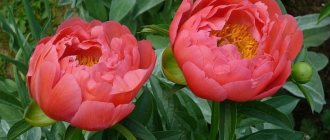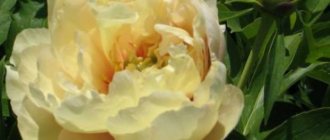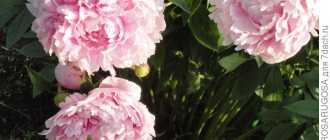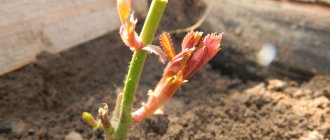How to care?
Caring for plants is no different from caring for other herbaceous hybrid peonies. The only peculiarity is that during the flowering period it is better to shade them slightly. Then the flowering will last longer, and the coral color will stay stronger and will not fade by the end of flowering.
Watering
Pink Hawaiian Coral peonies do not require regular watering. This is one of the most unpretentious and stable varieties of peonies. However, if you want to improve flowering and the general condition of the plant, you can water during the following periods:
- Budding period. If the plant receives additional moisture at this time, you can count on abundant flowering.
- Bloom. Watering a flowering plant will delay the fall of the petals.
- Periods of severe natural drought.
- End of June – beginning of July. At this time, peonies are laying renewal buds, and additional moisture will make their task easier.
- Mid – end of August. If the plant is given plenty of water in late summer, it will form more adventitious roots, which will improve its survival and drought tolerance.
In general, watering for peonies is not as important as light and temperature conditions, so only watering during drought is mandatory.
Top dressing
Pink Hawaiian Coral peonies are fed three times per season:
- early spring (nitrogen fertilizers);
- during the period of bud formation (mineral fertilizers for flowering plants);
- after flowers bloom (potassium-phosphorus fertilizers).
Fertilizer application is aimed primarily at improving flowering. The first feeding in early spring is necessary for the active growth of the green part of the plant.
Protection from pests and diseases
The key to a healthy plant is a properly selected planting site and appropriate soil conditions. Peony Pink Hawaiian Coral, planted in suitable conditions, will have natural immunity and resistance to pests and diseases.
If a plant is infested with pests, insecticides suitable for controlling this type of insect should be used.
Features of growing the pink hawaiian coral variety
The selection of a place for the growth of this plant should be taken as responsibly as possible. To ensure that the efforts invested in caring for Pink Hawaiian Coral peonies are not in vain, you need to choose the right planting site. The survival rate and intensity of flowering in the future depends on this.
The main criteria for choosing a landing site are:
- illumination;
- surrounding buildings;
- compatibility with other perennials already growing around.
It is best to choose an open, well-lit place. Lighting is the key to abundant and high-quality flowering. In shade and partial shade, the flowers will be relatively small. For most gardeners, this is a minus, but in some situations you can use this in a flower arrangement. For example, if there is no illuminated place for a peony flower bed, you can plant plants with especially small flowers around it. If at the same time you provide high-quality care for the plant, the game of contrast will be successful and even peonies grown in the shade will look majestic.
Important! It is not advisable to plant Pink Hawaiian Coral peonies near permanent buildings. The fact is that the walls emit additional heat, and on especially hot days this will negatively affect the condition of the plant. As a result, the flowers will lose their appearance, and the leaves will fade and become less shiny.
How to plant Pink Hawaii Coral Peony
August is best for transplanting or rooting cuttings, although some gardeners also practice spring replanting of herbaceous peonies. The place for growing Paeonia Pink Hawaiian Coral should be fertile plots of land, prepared in advance for planting root cuttings.
Important! Peony Coral Pink should not grow in dense shade. Even bushes planted in partial shade will not be decorated with the number of buds that Paeonia Pink Hawaiian Coral will form in the sun
In addition to bright sunlight, the plant needs loamy soil, into which organic fertilizers are added during autumn planting - rotted manure, humus, vermicompost. Nothing should grow in the selected area in summer.
A week before planting, you can begin to prepare the planting hole. Its size should not be too large, a depth of about 40-50 cm, a width of 60 cm is sufficient. 3-4 tbsp is added to it. spoons of superphosphate and 1 cup of wood ash, sprinkled on top with a layer of garden soil taken from the same hole. Two days before planting the cutting, the hole is filled with water with any fungicide dissolved in it. After the soil has subsided, add a small layer of dry soil again.
Note! To sandy soil you need to add clay and chernozem, to clay soil - sand and peat.
Peony planting hole
Landing
On a bush intended for replanting or dividing into cuttings, all stems are shortened to a height of 10-15 cm. The peony bush removed from the soil is left to dry the soil. The dried soil is removed, and the rhizome is cut into sections using a sharp garden knife. Each one should have at least 3 growth buds left. All parts of the roots must be healthy, without signs of rot or damage by insects or rodents.
The divisions are immersed in a solution of any growth stimulator for 2-3 hours. To quickly root peonies, gardeners often use heteroauxin, rootvin, epin, and zircon, which have been proven over the years. Then the pieces of rhizome should dry out within a few hours. After this, you can begin planting. The delenki are placed in a hole at an angle and covered with earth.
Important! The growth buds cannot be buried in the soil. Peony bushes do not tolerate swampy and waterlogged areas; on such lands, flowers quickly die from root rot
Peony bushes do not tolerate swampy and waterlogged areas; on such lands, flowers quickly die from root rot.
Dividing rhizomes before planting
Caring for Paeonia Pink Hawaiian Coral
The Pink Hawaiian Coral peony grows in one place for at least 10 years without losing its decorative qualities. This is possible provided that the plant is planted in fertile soil and then cared for annually. Caring for flowers is simple:
- In spring and autumn, mineral fertilizers are applied to the root zone under the peony bushes - nitrogen in the spring, phosphorus in the fall. In summer, during flowering, fertilize with a potassium-phosphorus complex once;
- throughout the entire season, make sure that the soil in the root zone does not dry out and does not become covered with a soil crust; so that there are no weeds near the bushes that can choke or shade the plants;
- Watering is carried out as the soil dries to a depth of about 5 cm. Water for irrigation is taken from a spring or well. If there is a lot of mineral sediments in the water, it is settled, the same is done with tap water. It cannot be too cold or warm, the best option is room temperature;
- during flowering, the crumbling inflorescences are cut off from the bushes;
- In spring, flowers are treated with fungicide solutions to prevent fungal diseases, in summer - with insecticides to kill ants that bring aphids to the buds.
Typically, plants that have lived in one place for more than 10 years slow down their growth, reduce the number of buds and the size of flowers. The reason for this is that the peony root system has gone deep into the ground. Despite their impressive size, the roots cannot supply nutrients to the upper part of the bush from the deeper layers of the soil. The reason is that there are very few of them at great depths. The solution is to carry out in-depth feeding or replant the bush.
Falling inflorescences worsen the appearance of the bush
How to properly grow Pink Hawaiian Coral peony in open ground
Pink Hawaiian Coral peonies are perennial plants whose surface parts die off during the winter. The root part of the bushes overwinters in open ground and tolerates fairly severe frosts.
Every spring, the plants are reborn, then young green shoots appear, which are dressed in emerald shiny narrowed foliage, and then buds set and bloom.
Note! Unfortunately, the Pink Hawaiian Coral peony has insufficiently strong stems, so during the mass blooming of buds, the flowering bushes begin to fall apart.
There are 2 ways to help plants not droop their branches:
- put a ring on the bush, standing on long legs recessed into the soil;
- in the spring, before the shoots begin to sprout, place a bush-sized square of thick plastic mesh with large cells on top of the underground part of the peony; stem shoots will sprout through them. As the stems grow, the mesh is raised to the required height and reinforced with additional posts.
Peony bush with support device
How to plant coral peonies?
Peony is a very beautiful plant. It is not surprising that many gardeners choose it. But in order for the culture to be pleasing to the eye, you need to know how to plant peonies. Experienced flower growers advise planting peonies in the ground in early autumn. Although in some cases you can do culture at the end of August. But still, experts recommend waiting until mid-September. This period is ideal in that the buds are fully formed.
How to plant peonies correctly is described below:
- Choosing a location. It is advisable that the site is on the sunny side and protected from the wind. For example, you can plant a plant near a bush or tree. The main thing in this case is to maintain a certain distance so that the roots grow and develop freely. It is also necessary to build a barrier from the wind. Peonies should not be planted close to home. After all, the walls radiate heat. Constant overheating is destructive for a flower. A space of 1.5-2 meters must be maintained between the building and the pit.
- Land preparation. She must be fertile. To improve the composition of the soil, nutrients should be added. Peony prefers loamy soil. But heavy clay ones are not suitable. But the situation can really be corrected by adding clay in combination with humus and peat. Peaty soils are not suitable.
- Fertilizer application. Before planting a young plant, a mixture consisting of ash, potassium sulfate and superphosphate is added to the hole. Water the top with a manganese solution.
- Planting and care. Make a small mound at the bottom of the hole. A division will be placed on it. The roots should be carefully straightened. Fill the voids with soil. It is required to plant so that there are several centimeters of soil above the top bud. After planting, irrigate and mulch. For mulching, use hilled soil with spruce branches or compost.
Growing rules
The peony looks great both in flower beds, flower beds, and planted alone. It can be used for cutting and decorating flower arrangements. Sometimes bushes are even used as hedges.
Features of growing the variety:
- The flower does not tolerate deep planting. In this case, it may not even release the inflorescences.
- Watering should be moderate - no more than once a week. After watering, do not forget to loosen the soil.
- The plant loves fertile soil. It can grow anywhere, even in full sun. Although for more comfortable growth it is best to plant in partial shade.
- You need to fertilize the peony three times throughout the entire season, no more. The first feeding is done at the beginning of May, with a urea solution. Then the second and third with a frequency of 1 time in 20 days. After flowering, a complex fertilizer should be applied.
Ideal soil for a hybrid
The soil for peony should be very fertile, containing organic and mineral fertilizers. The planting hole must be at least 60x60x60 cm. The top layer of the removed soil is mixed with humus, compost, and manure.
Necessary mineral fertilizers:
- granulated superphosphate – 300-400 g;
- potassium sulfate – 150-200 g;
- bone meal – 400 g;
- tuff or dolomite flour – 200-300 g;
- copper sulfate – 35-40 g.
All fertilizers are thoroughly mixed with the soil and the hole is filled. It is prepared 2-3 weeks before planting. For top filling, only fertile soil is used.
Interesting! If all mineral and organic fertilizers were used during planting, then in the first year the plant does not need to be fertilized. It will receive all the necessary nutrients for healthy growth and flowering.
How to water and fertilize?
Peony does not require frequent watering. Its roots are strong enough and accumulate moisture sufficient for plant growth. Therefore, you only need to water dry soil, using 2-3 buckets per bush.
Attention! Frequent watering and high humidity can destroy the plant. One good watering per week is enough
Loosening frees air access to the roots. Otherwise they may rot.
Feeding frequency:
- March – aqueous solution of urea (50 g per 10 l of water);
- after 20 days – urea solution with universal fertilizer (1 tablet);
- after 20 days - urea solution with the same fertilizer (2 tablets);
- autumn feeding - complex mineral fertilizer; Watering is done from a watering can with a fine sieve in cool cloudy weather or in the evening.
The best organic fertilizers for peonies are manure and bird droppings. But they must be diluted with water. A bucket of cow manure takes 5 buckets of water, but a bucket of bird droppings takes 25 buckets of water. The solution is not used immediately; it must sit for two weeks.
Autumn-winter cares for flowers
If you take care of your plants in autumn and winter, they will definitely respond to you with friendly flowering. In the fall, do not forget to feed peonies so that nutrients accumulate in the root system. If you use a complex fertilizer, it must contain potassium and phosphorus.
Important! Nutrients will penetrate the soil and roots faster if they are not in dry form, but in the form of a solution. Be sure to prune peonies for the winter
This is done when frost occurs. Shoots are cut as close to the ground as possible
It is imperative to prune peonies for the winter. This is done when frost occurs. The shoots are cut as close to the ground as possible.
Replanting peony variety Carol is also best done in the fall. So by spring the flower will have already begun to grow and gain strength, and will delight you with lush blooms.
Landing
Planting Pink Hawaiian Coral peonies must be carefully considered, because it includes several stages, the correct execution of each of which is extremely important.
When and how to plant?
It is best to dig a planting hole for Pink Hawaiian Coral peonies a week or two before the intended planting. In this way, the deep layers of the soil are saturated with atmospheric air, which has a good effect on survival rate. The hole should be dug wide enough so as not to deform the root system when planting - peonies of this variety are very sensitive to root injuries.
The planting time is very short: transplantation can only be done at the end of August - beginning of September, depending on the region of residence. This is due to the short period of peony life between the end of flowering and dying off for the winter.
What soil is suitable?
Slightly alkaline soil is suitable for coral peonies, so before planting you should figure out what type of soil predominates in the area. There are several ways to determine the reaction of the environment in the soil:
- Checking soil pH in the laboratory. The most accurate way.
- Identification by weeds prevailing on the site. Many species are indicator plants.
- The color of the soil indicates its chemical composition, and, accordingly, its chemical properties. There are color samples corresponding to soils of varying degrees of acidity.
The most common case is highly acidified soil. To change its pH toward alkaline, dolomite flour or ash is used. The intensity of fertilization depends on how much the soil type will have to be changed.
Other coral varieties
Coral varieties of peonies are a separate group. It includes a wide variety of varieties. The most popular of them will be discussed below.
Coral pink
This variety is preferred by experienced gardeners. It is an intraspecific variety derived from Paeonia lactiflora. This peony was first bred in 1937 in the United States. The plant reaches a height of 60–70 cm. A characteristic feature is very strong shoots. Light green leaves form on the stems.
This is a medium-late flowering variety. Terry anemone-like buds are formed on the bush, which are colored light coral pink. The size of the inflorescences is average. The diameter of the buds is about 12 cm. The inflorescences emit a faint aroma.
Coral Beach
The plant grows up to 90 cm in height. The entire stem is abundantly covered with leaves. The color of the leaf blade is dark green. Large buds are formed at the ends of the shoots, the diameter of which when opened is about 17 cm. Each stem ends in three or more buds.
The shape of the inflorescences resembles a water lotus. The buds are beautiful and semi-double. They have a bright yellow core. This variety differs from others in the milky, soft coral color of its inflorescences. They exude a pleasant sweetish aroma.
Early flowering variety. The main advantages of this variety include:
- drought resistance;
- frost resistance;
- resistance to gray rot.
This type is suitable for both group and single planting.
Fairy Coral
This variety is considered an interspecific hybrid. It was bred by a breeder from the USA in 1972. The plant looks like a low shrub. The height of the bush usually grows no more than 75 cm. It is characterized by a rounded crown. The leaf blade is heavily cut. It has a light green color, which gives the plant a decorative appearance.
Semi-double buds are formed on the shoots during the flowering period. Their petals are colored coral pink. The peculiarity of the variety is that the central part of the inflorescence is painted in darker colors. The buds are large. On average, their diameter is about 16 cm. They exude a pleasant and subtle aroma that gives the flower sensuality and elegance.
Fairy Coral flowers form early. The species is characterized by excellent frost resistance.
Photos and characteristics of peonies Pink Hawaiian Coral
This variety owes its origin to American breeders. These unusual flowers appeared in the assortment of garden stores and nurseries relatively recently - in 1981, but have already gained popularity in landscaping.
The main distinctive features of the variety:
- life form – herbaceous plant;
- peony height up to 80 cm;
- strong juicy stems;
- leaves are leathery, with a characteristic shine;
- coral-colored flowers, up to 20 cm in diameter;
- pleasant aroma reminiscent of freshly cut grass.
The picture is completed by bright yellow stamens, densely located in the center of the corolla, surrounded by petals.
The most attractive features of this variety are its undemandingness to temperature conditions and the durability of cut flowers. Genetically embedded in the structure of this variety is the ability to withstand low temperatures, which allows them to be grown in relatively harsh habitats and without additional shelter during frost periods. In addition, cut flowers, if special rules are followed, will last in a vase for several weeks.
Pink Hawaiian Coral is classified as an early variety of peonies. Depending on the region of planting, the buds bloom in April-May. Flowering continues for three weeks or more. A favorable condition for longer flowering is cool, windless weather. This variety is used in landscaping front gardens, grown in flower beds, flower arrangements, and flower beds.
History of coral varieties
The sixties of the last century were marked by the beginning of the period of selection of peony varieties of coral shades. The most notable results in this work were achieved by the American Sam Wissing and the Canadian scientist Lyman Cousins. They created varieties and varieties of Coral peony, which soon became very popular among beginning and experienced gardeners.
Thanks to the work of modern breeders, today there are about five thousand varieties and species of coral peonies. The most popular and in demand in our country include:
- Coral pink.
- Hawaiian Coral.
- Coral Beach.
- Fairy coral.
- Coral Sunset.
Today we will talk about only one of them.
What do coral peonies look like?
Peony is a plant that belongs to the perennial class. It comes in different types: shrubby, semi-shrubby and herbaceous. The crop often has several stems. On average, the height does not exceed a meter.
Gardeners greeted the appearance of unusual coral-colored peonies with great enthusiasm, but it should be noted that coral color does not indicate a specific shade. For example, the buds of a plant may have a light orange-pink color or a darker tone. In the 60s of the twentieth century, a period of breeding varieties of coral-colored peonies began. The greatest results in this area were achieved by Canadian scientists Lyman Cousins and American Sam Wissing. They created Coral peony varieties, which later began to be in good demand among experienced and novice summer residents.
A detailed description of the Coral peony is given below:
- The root system is quite powerful.
- The leaves are trifoliate and pinnately divided. They are arranged in the following order. The color ranges from dark green to dark purple. It is extremely rare to find varieties with a bluish color. By autumn, the leaves acquire a yellow, reddish color.
- The diameter of the opened bud is from 15 to 25 centimeters. The flower has a multi-leaf, complex, star-shaped shape. The inflorescences are lush and beautiful.
- The seeds of the plant are quite large. Their shape is oval and round.
How to plant coral peonies?
Peony is a very beautiful plant. It is not surprising that many gardeners choose it. But in order for the culture to be pleasing to the eye, you need to know how to plant peonies. Experienced flower growers advise planting peonies in the ground in early autumn. Although in some cases you can do culture at the end of August. But still, experts recommend waiting until mid-September. This period is ideal in that the buds are fully formed.
How to plant peonies correctly is described below:
- Choosing a location. It is advisable that the site is on the sunny side and protected from the wind. For example, you can plant a plant near a bush or tree. The main thing in this case is to maintain a certain distance so that the roots grow and develop freely. It is also necessary to build a barrier from the wind. Peonies should not be planted close to home. After all, the walls radiate heat. Constant overheating is destructive for a flower. A space of 1.5-2 meters must be maintained between the building and the pit.
- Land preparation. She must be fertile. To improve the composition of the soil, nutrients should be added. Peony prefers loamy soil. But heavy clay ones are not suitable. But the situation can really be corrected by adding clay in combination with humus and peat. Peaty soils are not suitable.
- Fertilizer application. Before planting a young plant, a mixture consisting of ash, potassium sulfate and superphosphate is added to the hole. Water the top with a manganese solution.
- Planting and care. Make a small mound at the bottom of the hole. A division will be placed on it. The roots should be carefully straightened. Fill the voids with soil. It is required to plant so that there are several centimeters of soil above the top bud. After planting, irrigate and mulch. For mulching, use hilled soil with spruce branches or compost.
Knowing when to replant peonies and how to carry out this procedure correctly, there is every chance of growing a beautiful shrub that will delight you with abundant flowering. Without transplantation, a peony can grow for about 8-10 years. After which the bush is divided and transferred to a new place. They are usually replanted in the fall. But some gardeners are wondering whether such an event can be held in the spring. In principle, this is not prohibited
But it is important to remember that then such bushes will not bloom in the summer. And it will be much more difficult for the plant to withstand the heat.
Therefore, replanting peonies in spring is extremely rare.
Diseases, pests and ways to combat them
Main pests and diseases of peonies:
Rust. Spots on leaves and shoots. Collect and burn shoots and leaves, spray the plant with 1% Bordeaux mixture. The same measures for phyllostictosis (small brown spots with a dark purple rim, premature drying of the leaves), brown spot (large brown spots, the leaf looks like it’s burned) and brown spot (bilateral brown-brown round or elongated spots with a darker rim, leads to to weaken the bush).
Unique peony color Coral Pink
- Gray rot. A gray coating appears at the base of the stem, then it darkens and breaks. Large brown spots appear on the tips of the leaves. The leaves become deformed and dry out. Small buds turn black and also dry out. The edges of the blossoming petals turn brown and dry out. The control method is correct agricultural technology and treatment with fungicides.
- Powdery mildew. Recognized by a whitish coating on the upper part of the leaves. Treatment with soap and soda solution.
- Ring mosaic of leaves. On the leaves, light green and yellowish stripes, rings, and half rings form between the veins. Viral disease, collect damaged shoots and burn. In case of severe damage, the bush is destroyed.
Peony variety Pink Hawaiian Coral will delight you with lush flowering in early summer. The plant is characterized by a unique picture of buds burning in the light.
External qualities and flowering times
Peony variety Coral Sunset has the following description:
- a powerful and well-leafed bush, which consists of erect stems and has compact dimensions;
- shoots rise 12–15 cm above the green mass. Their length can reach 90 cm;
- the bud forms at the end of the stem;
- The color of the mature inflorescence is deep coral. Its middle is always lighter than the tips of the petals;
- The buds are semi-double, cup-shaped. Their diameter is 18–20 cm.
Such structural features of the bush allow you to collect beautiful bouquets of flowers. With a daily change of water in the vase, cut inflorescences will retain their beautiful appearance for 7–10 days. To do this, you can add boric acid, vinegar or sugar to the water.
The flowering period is long. With proper care, Coral Sunset will bloom for 4-6 weeks. The first flowers begin to form in early June. The buds not only look gorgeous on the bush, but also exude a pleasant aroma.
At the beginning of flowering, the inflorescences of this variety are painted in a rich peach-pink color, which is diluted with a blood-red coral tint. Towards the end of this period, the color scheme of the petals changes. They take on a yellowish tint. In this form, the inflorescences also look quite impressive against the background of bright green plant mass.
Interestingly, the middle of the flower does not undergo color changes throughout the flowering period. It always remains lighter than the surrounding petals. In this case, the petals before and after changing their color still remain with dark tips.
As for the leaves, they retain their bright green color throughout the growing season, giving the bush a decorative appearance.
Description of peony Pink Hawaiian Coral
The frost-resistant peony Pink Hawaiian Coral was created by breeders from Holland. Awarded the Gold Medal of the American Peony Society (APS). Its coral inflorescences change their colors twice during the flowering season. At the beginning of May, the barely blossomed petals of the flower, collected in a semi-double cup-shaped inflorescence, can have a lilac-pink, bright pink-orange, almost crimson hue. Thin white-pink or dark pink veins are visible on the inside of the petals.
Blooming Paeonia Pink Hawaiian Coral Flower
As the petals bloom, the color scheme of the petals changes; they can become apricot or pale peach. In the center of the bud are bright yellow stamens and cream pistils. Their appearance makes the flower even more elegant.
For your information! The diameter of fully blossomed Pink Hawaii Coral peonies can reach 16 cm.
The height of 3-4 year old plants is about 90 cm. Flowering is accompanied by a faint sweetish aroma of hay. Pink Hawaiian Coral milk peonies look especially impressive in group plantings. They are readily used to decorate ponds in personal gardens, paths in parks and gardens, and flower beds.
Paeonia Pink Hawaiian Coral Bush
Diseases and pests
If we talk about diseases that are common among peonies, the following are considered the most dangerous.
Gray rot. It appears in the form of brown spots, which first appear only near the base of the stems, and then spread throughout the entire bush. In addition, small peony buds can also be affected. To get rid of this disease, you can cut off all the affected parts and burn them. At the same time, new ones do not grow. The bush must be treated with a solution of potassium permanganate or use a more effective chemical preparation, for example, “Fundazol” or “Sumilex”.
Description:
Hawaii in your garden, how can this be? A piece of Hawaiian sunshine can appear on your site by planting the radiant peony Pink Hawaiian Coral (Pink Hawaiian Coral)
. To the delight of all gardeners, American breeders in 1981 produced an amazingly beautiful flower.
of Pink Hawaiian Coral peony opens with apricot radiance
with a diameter of 16 cm. A semi-double beauty when fully bloomed can change its shade, so the color can be coral. The center of the flower is abundantly strewn with bright creamy stamens. Despite the name, it is a flower with a truly Russian soul; when it blooms, it exudes the scent of freshly cut hay.
Bush Pink Hawaiian Coral
tall 80 cm and strong, densely covered with green glossy foliage.
Peony of the Pink Hawaiian Coral variety
is an early flowering plant; already in early May it will generously reward you with its abundant flowering. Excellent for decorating flower beds and also resistant to cutting.
Peonies planted in well-fertilized soil do not need to be fertilized in the first year and several subsequent years. After transplantation, varietal qualities appear in 2-3 years! In autumn, with the onset of stable frosts, around mid-October, the stems of peonies are cut off, leaving stumps 1-2 cm high above the buds. For the winter, peonies are covered with a layer of peat or unripe compost. There is no need to cover adult plants.
To send Pink Hawaiian Coral peony (Pink Hawaiian Coral)
a standard division with 2-3 buds is used in the amount of 1 piece.
Delivery is carried out by Russian Post, transport companies PEK, SDEK or others as agreed with you.
Order and buy peony seedlings Pink Hawaiian Coral (Pink Hawaiian Coral)
You can click the “Add to Cart” button and place your order.
Type of packaging:
a bag of peat, a label indicating the variety, a standard section with 2-3 buds.
Delivery terms:
Orders with peony seedlings are sent in the autumn, from September 1, and spring, from March 1, seasons (shipping restrictions in accordance with the customer’s climate zone).
| Jan | February | March | Apr | May | June | July | Aug | Sep | Oct | Nov | Dec |
| Landing | |||||||||||
| Landing II |
Peony Pink Hawaiian Coral - what kind of variety is it?
The variety received the American Peony Society Gold Medal award in 2000 and the American Peony Society Award of Landscape Merit in 2009. Frost-resistant, can grow in climate zones with temperatures of -45 ℃. Detailed description of the variety:
- Perennial bush.
- Semidouble.
- Bush height 60-90 cm.
- The stems are strong, there is only one flower per shoot.
- One-time flowering.
- Flower diameter is up to 16-20 cm.
- The color of the outer petals is coral, pink, light pink, and apricot when fully bloomed.
- The petals in the center are creamy yellow or cream in color. Anthers golden, yellow.
- The aroma is sweet, soft, and may smell like rotten hay.
- Early flowering variety.
Pink Hawaiian Coral peony flower has a size of up to 16-20 centimeters
Advantages and disadvantages of the variety
Peony variety Pink Hawaiian Coral has large flowers with a diameter of 16-20 cm. It blooms early and very profusely. The bush has tall, strong stems, does not require mechanical support, and is good for cutting. The variety is frost-resistant and has reliable inheritance of traits during propagation.
It may have an unpleasant flower smell and requires deep tillage and constant qualified supervision. If poorly maintained after flowering, it is not aesthetically pleasing.
Pink Hawaiian coral peony blooms profusely
Using peony in landscape design
Pink Hawaii Coral peony has a fairly tall growth and large, abundant flowers. You need to carefully choose a place to place it and think about the neighborhood. To decorate the territory, plants are planted in groups.
By combining Pink Hawaiian Coral peony with other varieties you can achieve long flowering. During this period, it will add volume and splendor to the flower arrangement. In combination with late-flowering varieties of the same color scheme, it makes it easier to build a long-term composition.
On a note! The variety looks great against the backdrop of shrubs and trees, and irises, bells, and decorative onions will fit perfectly in front of it.
Preparing for winter
With the beginning of the death of the surface parts of peonies, the processes of accumulation of nutrients begin in the roots of flowers. The peony will need them in the spring, during the first growing season, and in winter to slowly feed the root buds located almost on the surface of the soil. Buds form in the fall when the stems die. Blackened stems are cut off, leaving small stumps.
Although Paeonia Pink Hawaiian Coral is not afraid of severe frosts, gardeners usually do not take risks and cover the bushes with a layer of mulch or agrofibre. To prevent the flower from being drowned by rain and melt water, a raised frame is installed above the plant on top of the mulch and a layer of slate is laid.
Important! All layers of shelter are removed in the spring before the onset of warm weather. Flower growers know that the peony bush will fully show its beauty only in the third year after planting, and the first two cut off all the buds so that the blossoming flowers do not take away the strength from the still insufficiently developed roots
But when the time comes and the Pink Hawaiian Coral peony blooms, people never tire of admiring its coral beauty and strive to have more than one bush of this variety growing in the garden.
Flower growers know that the peony bush will fully show its beauty only in the third year after planting, and the first two cut off all the buds so that the blossoming flowers do not take away the strength of the still insufficiently developed roots. But when the time comes and the Pink Hawaiian Coral peony blooms, people never tire of admiring its coral beauty and strive to have more than one bush of this variety growing in the garden.
Basic rules for growing Coral Sunset peonies
To grow a healthy and strong peony bush, you must follow the growing rules and approach the issue of planting with all responsibility.
What should you pay attention to when growing Coral Sunset peonies?
Landing place
The area where the plant will grow should be well lit by sunlight, but at the same time isolated from strong winds. The shady side adversely affects the abundance of flowering. It is optimal to place the bush next to a hedge or tree, but in this case it is necessary to maintain a distance so that the roots grow and develop unhindered.
It is not recommended to plant peonies near the house, since warm walls can become an additional source of heat, which is detrimental to the plant during the hot period. If the irresistible desire to admire flowers from the window forces you to plant them nearby, then it is advisable to place the planting holes at least 2 m from the building.
Soil requirements
Loamy, well-drained soil is considered best for growing Coral Sunset peonies. It should be fertile and quite loose, since the plant will feel uncomfortable in clay soil. If heavy soil predominates in the garden plot, then you will have to build a flower bed and replace the soil cover.
To do this, unsuitable soil is dug to a depth of half a meter, and the resulting hole is filled with a soil mixture of sand (1 part), turf soil (2 parts) and organic fertilizers (2 parts).
Time to board
Peonies of this variety are usually planted in late August-early October. Cooling the air to 12 degrees promotes the growth of suction roots in peonies, which will certainly take root well. Spring planting is also allowed, but it will be difficult for the seedling to withstand the summer heat, and flowering in the summer of the current year may not be expected.
Landing technology
The Coral Sunset peony is planted using the following technology:
- Dig planting holes 50-60 cm deep, and the distance between them should be at least 1 m. If there is an excess of moisture in the soil, the hole is deepened another 20 cm so that there is enough space for the drainage mixture and gravel.
- The root collar is located in the hole so that the upper bud is slightly below the edge of the hole, about 3-5 cm. Too much or too little recess will lead to a lack of flowering.
- The root system is carefully sprinkled so that there are no air voids left inside the hole. Otherwise, the roots will begin to dry out.
- The earth is trampled down, and a loose, uncompacted embankment 4-5 cm high is formed around it.
- The plant is watered thoroughly.
Under planted peonies, it is necessary to maintain moist soil, but not allow excessive dampness.
Is it necessary to mulch?
The soil under Coral Sunset peonies should be amended with dry grass, straw and sawdust only during dormant periods. In the fall, the flower beds are mulched, and in the spring the layer of mulch is removed. If this is not done, then the sprouts may simply not break through it.
Planting by seeds
Most gardeners do not use seeds to propagate Paeonia Pink Hawaiian Coral. Seedlings obtained after seed germination do not have the qualities endowed with the parent plants. But if you still have the task of growing a seedling from seeds that have a beautiful name, consonant with the Pacific coral island, then first you need to purchase high-quality seeds of these peonies and check their germination.
Then the seeds are treated with a fungicide or simple pale pink potassium permanganate, washed in running water, dried and placed in flower pots with a soil substrate of neutral acidity, buried 5 cm. This is done in August-September, approximately 30 days before the onset of cold weather. Pots are buried in the garden for the winter. The seeds need to stay in the cold, preferably under snow or mulch, for at least 2 months. In the spring, with the onset of warmth, peony seeds should germinate.
Note! In autumn, seedlings are transplanted from flower pots to a flower bed.
Conclusions about coral peonies
Peonies have become increasingly popular lately. Many gardeners grow them. In addition to the standard color, peony can be coral. There are many varieties of coral species. Gardeners especially loved Sunset, Beach, Charm, Pink, Hawaiian, Fairy and Supreme. Therefore, these are the varieties that were discussed in detail in the article. It must be said that the plant develops well in the middle zone and is ideal for growing in domestic climatic conditions. The culture tolerates frosty winters, heavy rainfall, as well as dry and hot summers. The main thing is to perform a competent planting and then properly care for the peony.
What varieties of coral peonies exist today?
Thanks to the painstaking work of breeders from many countries, more than 5,000 varieties of this amazing plant are currently known. So there is plenty to choose from. Let's consider the most popular options among summer residents.
When thinking about purchasing coral peony seeds, you should pay attention to the following varieties:
- Coral Pink.
- Hawaiian Coral.
- Coral Beach.
- Coral Fairy.
- Coral Sunset.
- Coral Supreme.
- Coral Charm.
- Coral en Gold.
- Coral Magic.
- Cora Louise.
- Topeka Coral.
- Coral Louis.
Peony Coral Pink
Among experienced flower growers, the Coral Pink peony is very popular. The variety is considered intraspecific from p. lactiflora. It was released in 1937 in the USA. Flower characteristics: anemoid, double inflorescences. Their color is light coral pink. The open bud is medium in size. The diameter is about 12 centimeters. The shrub reaches a height of 60-70 centimeters. Peony Coral is characterized by very strong stems. The leaves are colored in a light green tone. Medium late variety. The aroma of flowers is weak. Gardeners give the highest rating to Coral Pink.
Peony Hawaiian Coral
Reviews for the Hawaiian Coral peony are also mostly positive. The variety was bred by American scientists in 1981. It is considered herbaceous and universal. Blooms abundantly, once. The plant is herbaceous. The bush grows up to a meter. The shoots are very strong. Densely covered with glossy green foliage.
The opened bud has a diameter of about 20 centimeters. The flowers are semi-double, apricot-colored. In the center of the inflorescence are bright creamy stamens. Hawaiian Coral exudes the smell of freshly cut hay. The variety is valued for its good winter hardiness and early, abundant and long-lasting flowering. Hawaiian Coral is often grown in areas with cold climates. Peony is resistant to cutting. It is an excellent choice for decorating flower beds.
Peony Coral Beach
The Coral Beach peony is characterized by its soft coral color and milky flowers. The height reaches 90 centimeters. The stem is densely covered with dark green foliage. The size of the flower when opened is 17 centimeters. The shape resembles a water lotus. The bush blooms early. The inflorescences are semi-double, beautiful, with a bright yellow center. They emit a sweet, pleasant aroma. The variety has a number of advantages: frost-resistant, drought-resistant, and immune to gray rot. Each stem produces 3 or more flowers. Coral Beach is one of gardeners' favorite varieties. Can be used for both single and group planting.
Peony Coral Sunset
The Coral Sunset peony is also in good demand among beginners and professional gardeners. This is a herbaceous perennial plant. The bush is compact. The stems are tall and straight. The height is 90 centimeters. Inflorescences are semi-double, cup-shaped. Their diameter ranges from 18 to 20 centimeters. The buds are painted in an unusual peach-pink tone with an admixture of red coral. However, towards the end of flowering the petals become yellowish. Both shades look good and harmonize with the bright green foliage of the crop.
As for the leaves, they retain their color throughout the season and look very decorative. Many people loved the Coral Sunset peony for its pleasant aroma.
Peony Coral Charm
The herbaceous peony Coral Charm can become a real decoration of the garden plot. The culture is distinguished by its original coloring. At the beginning of flowering, the bud is dark pink in color. And as it blooms, it acquires a light coral hue with a white border along the contour of the petals. Towards the end of flowering, the color turns yellow. Inflorescences are semi-double. Quite large in size. They reach 20 centimeters in diameter. Each bud consists of 8 rows of petals. Due to this it looks incredibly lush and luxurious.
The leaves are dark green. The stems have a reddish tint. Very durable, so they do not bend under the weight of large inflorescences. The height of the bush is a meter. Peony Coral Charm belongs to plants with early flowering. The culture begins to delight with its beauty already at the beginning of June. Each bud exudes a soft floral aroma. The decorative qualities of the variety are high. Therefore, Coral Charm is often chosen to decorate the garden.











